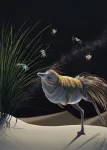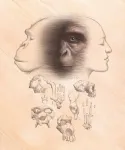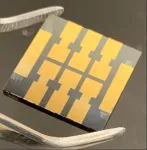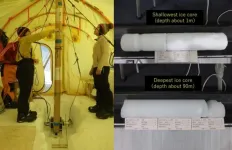Dinosaurs that hunted in the dark
The tiny desert-living dinosaur Shuvuuia had extraordinary vision and owl-like hearing for nocturnal life in the Mongolian desert
2021-05-06
(Press-News.org) Today's 10,000 species of birds live in virtually every habitat on Earth, but only a handful have adaptations enabling them to hunt active prey in the dark of night. Scientists have long wondered whether theropod dinosaurs - the group that gave rise to modern birds - had similar sensory adaptations.
A new study led by University of the Witwatersrand scientist, Professor Jonah Choiniere, sought to investigate how vision and hearing abilities of dinosaurs and birds compared. The international team of researchers used CT scanning and detailed measurements to collect information on the relative size of the eyes and inner ears of nearly 100 living bird and extinct dinosaur species.
To measure hearing, the team measured the length of the lagena, the organ that processes incoming sound information (called the cochlea in mammals). The barn owl, which can hunt in complete darkness using hearing alone, has the proportionally longest lagena of any bird.
To assess vision, the team looked at the scleral ring, a series of bones surrounding the pupil, of each species. Like a camera lens, the larger the pupil can open, the more light can get in, enabling better vision at night. By measuring the diameter of the ring, the scientists could tell how much light the eye can gather.
The team found that many carnivorous theropods such as Tyrannosaurus and Dromaeosaurus had vision optimized for the daytime, and better-than-average hearing presumably to help them hunt. However, a diminutive theropod named Shuvuuia, part of a group known as alvarezsaurs, had both extraordinary hearing and night vision. The extremely large lagena of this species is almost identical in relative size to today's barn owl, suggesting that Shuvuuia could have hunted in complete darkness.
The large lagena of Shuvuuia came as a surprise discovery to Dr. James Neenan, the joint first author of the study, and Choiniere's former post-doc at Wits. "As I was digitally reconstructing the Shuvuuia skull, I couldn't believe the lagena size...I called Prof. Choiniere to have a look. We both thought it might be a mistake, so I processed the other ear - only then did we realise what a cool discovery we had on our hands!" I couldn't believe what I was seeing when I got there - dinosaur ears weren't supposed to look like that!, "said Choiniere.
The eyes of Shuvuuia were also of note, as they had some of the proportionally largest pupils yet measured in birds or dinosaurs, suggesting that they could likely see very well at night.
Shuvuuia was a small dinosaur, about the size of a chicken, and it lived in the deserts of what is now Mongolia. Shuvuuia's skeleton is among the most bizarre of all dinosaurs - it has a fragile, bird-like skull, brawny, weightlifter arms with a single claw on each hand, and long, roadrunner-like legs. This odd combination of features has baffled scientists since its discovery in the 1990s. With the new data on Shuvuuia's senses, the scientific team hypothesizes that, like many desert animals, Shuvuuia would have foraged at night, using its hearing and vision to find prey like small mammals and insects, using its long legs to rapidly run that prey down, and using its strong forelimbs to pry the prey out of burrows or shrubby vegetation.
"Nocturnal activity, digging ability, and long hind limbs are all features of animals that live in deserts today," said Choiniere, "but it's surprising to see them all combined in a single dinosaur species that lived more than 65 million years ago."
INFORMATION:
[Attachments] See images for this press release:

ELSE PRESS RELEASES FROM THIS DATE:
2021-05-06
New Haven, Conn. -- If paleontologists had a wish list, it would almost certainly include insights into two particular phenomena: how dinosaurs interacted with each other and how they began to fly.
The problem is, using fossils to deduce such behavior is a tricky business. But a new, Yale-led study offers a promising entry point -- the inner ear of an ancient reptile.
According to the study, the shape of the inner ear offers reliable signs as to whether an animal soared gracefully through the air, flew only fitfully, walked on the ground, or sometimes went swimming. In some cases, the inner ear even indicates whether ...
2021-05-06
The findings, published in the journal Science today, demonstrate how integrating vertical descent and horizontal gene transfer can be used to infer the root of the bacterial tree and the nature of the last bacterial common ancestor.
Bacteria comprise a very diverse domain of single-celled organisms that can be found almost everywhere on Earth. All Bacteria are related and derive from a common ancestral Bacterial cell. Until now, the shape of the bacterial tree of life and the placement of its root has been contested, but is necessary to shed light on the early evolution of life on our ...
2021-05-06
The uncertainty principle, first introduced by Werner Heisenberg in the late 1920's, is a fundamental concept of quantum mechanics. In the quantum world, particles like the electrons that power all electrical product can also behave like waves. As a result, particles cannot have a well-defined position and momentum simultaneously. For instance, measuring the momentum of a particle leads to a disturbance of position, and therefore the position cannot be precisely defined.
In recent research, published in Science, a team led by Prof. Mika Sillanpää at Aalto University in Finland has shown that there is a way to get around ...
2021-05-06
In the 150 years since Charles Darwin speculated that humans originated in Africa, the number of species in the human family tree has exploded, but so has the level of dispute concerning early human evolution. Fossil apes are often at the center of the debate, with some scientists dismissing their importance to the origins of the human lineage (the "hominins"), and others conferring them starring evolutionary roles. A new review out on May 7 in the journal Science looks at the major discoveries in hominin origins since Darwin's works and argues that fossil apes can inform us about essential aspects of ape and human evolution, including the nature ...
2021-05-06
PROVIDENCE, R.I. [Brown University] -- A research team from Brown University has made a major step toward improving the long-term reliability of perovskite solar cells, an emerging clean energy technology. In a study to be published on Friday, May 7 in the journal Science, the team demonstrates a "molecular glue" that keeps a key interface inside cells from degrading. The treatment dramatically increases cells' stability and reliability over time, while also improving the efficiency with which they convert sunlight into electricity.
"There have been great strides ...
2021-05-06
MUSC Hollings Cancer Center researchers added to the understanding of the protective immune response against the SARS-CoV-2 virus in a study published in April in iScience. The team found that approximately 3% of the population is asymptomatic, which means that their bodies can get rid of the virus without developing signs of illness.
The researchers screened more than 60,000 blood samples from symptomless individuals in the Southeastern U.S., including Georgia, South Carolina and North Carolina, for the IgG antibody to the viral spike protein.
What began as a highly collaborative statewide effort to detect SARS-CoV-2 accurately, ...
2021-05-06
Recently published research from the University of Arizona Health Sciences shows that advanced-stage kidney cancer is more common in Hispanic Americans and Native Americans than in non-Hispanic whites, and that both Hispanic Americans and Native Americans in Arizona have an increased risk of mortality from the disease.
"We knew from our past research that Hispanic Americans and Native Americans have a heavier burden of kidney cancer than non-Hispanic whites," said Ken Batai, PhD, a Cancer Prevention and Control Program research member at the UArizona Cancer Center and research assistant professor of urology in the College of Medicine - Tucson. "But we also know that around 90% of the Hispanic population in Arizona is Mexican American - either U.S.-born or Mexican-born ...
2021-05-06
The air in the United States and Western Europe is much cleaner than even a decade ago. Low-sulfur gasoline standards and regulations on power plants have successfully cut sulfate concentrations in the air, reducing the fine particulate matter that harms human health and cleaning up the environmental hazard of acid rain.
Despite these successes, sulfate levels in the atmosphere have declined more slowly than sulfur dioxide emissions, especially in wintertime. This unexpected phenomenon suggests sulfur dioxide emission reductions are less efficient than expected for cutting sulfate aerosols. A new study led by Tokyo Institute of Technology (Tokyo Tech), Hokkaido University and the University ...
2021-05-06
The ability of antibodies to recognize specific cancer cells is used in oncology to specifically target those cells with small active agents. Research published in the journal Angewandte Chemie shows that scientists have now built a transport system that delivers even large protein-based drugs into cancer cells. This study demonstrates how proteins can arrive at their target intact, protected from destructive proteases by polymer brushes.
Developing anticancer treatments involves two recurring problems for researchers. An active agent needs to be able to kill the body's cells at the root of the cancer, and it should be active in target cancer cells rather than in healthy cells. Many medical researchers ...
2021-05-06
When you save an image to your smartphone, those data are written onto tiny transistors that are electrically switched on or off in a pattern of "bits" to represent and encode that image. Most transistors today are made from silicon, an element that scientists have managed to switch at ever-smaller scales, enabling billions of bits, and therefore large libraries of images and other files, to be packed onto a single memory chip.
But growing demand for data, and the means to store them, is driving scientists to search beyond silicon for materials that can push memory devices to higher densities, ...
LAST 30 PRESS RELEASES:
[Press-News.org] Dinosaurs that hunted in the dark
The tiny desert-living dinosaur Shuvuuia had extraordinary vision and owl-like hearing for nocturnal life in the Mongolian desert






